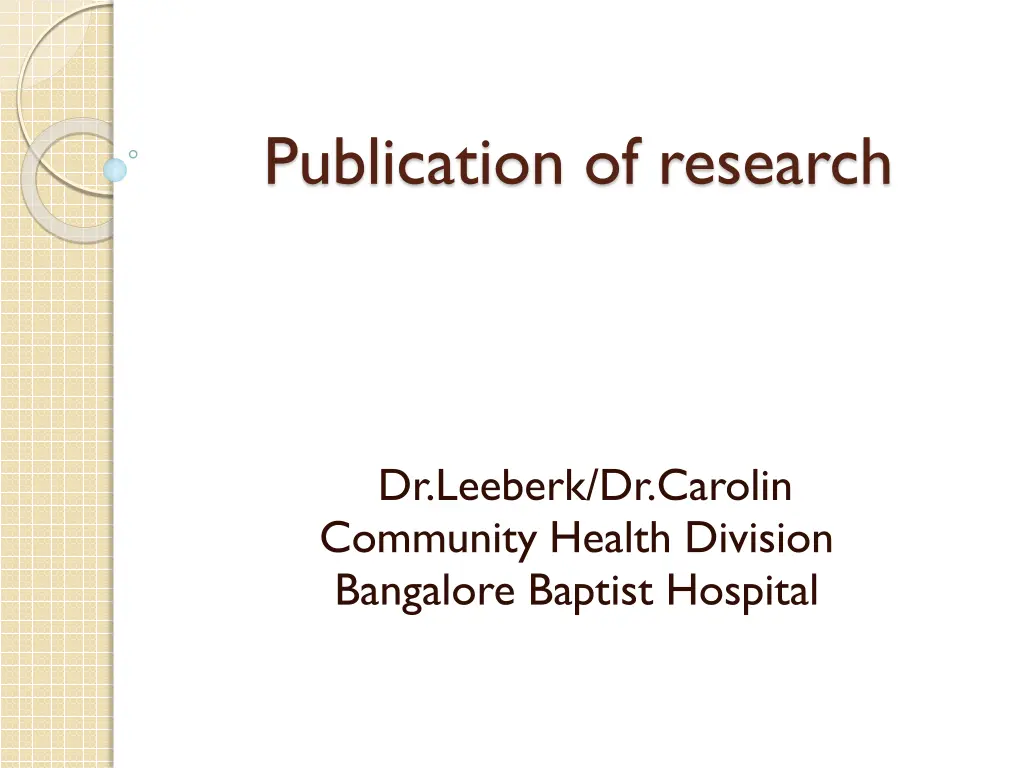
Insights into Research Publication Practices for Community Health Professionals
Explore the importance of research publication for community health experts, including benefits, considerations for publishing, journal selection criteria, impact factors, peer review process, and indexing significance. Enhance your understanding of why, when, and how to publish research effectively in this comprehensive guide.
Download Presentation

Please find below an Image/Link to download the presentation.
The content on the website is provided AS IS for your information and personal use only. It may not be sold, licensed, or shared on other websites without obtaining consent from the author. If you encounter any issues during the download, it is possible that the publisher has removed the file from their server.
You are allowed to download the files provided on this website for personal or commercial use, subject to the condition that they are used lawfully. All files are the property of their respective owners.
The content on the website is provided AS IS for your information and personal use only. It may not be sold, licensed, or shared on other websites without obtaining consent from the author.
E N D
Presentation Transcript
Publication of research Dr.Leeberk/Dr.Carolin Community Health Division Bangalore Baptist Hospital
Why Should I Publish my research? Improves writing skill Helps in knowledge up-gradation Keeps me updated Teaches me about literature search Creates a set of knowledge for others Publicity to my work Adds value to my career Keeps me alive as a researcher Motivate others to research Gives chance to externally access my work Makes me happy Should I publish only if get positive results?
Look for journals Narrow specialized journals General medical journals
Quality of journals Peer review Impact factor Indexed
Impact factor The impact factor of a journal is the average number of citations received per paper published in that journal during the two preceding years. For example, if a journal has an impact factor of 2 in 2018, then its papers published in 2016 and 2017 received 2citations each on average in 2008
Peer review Peer review is a process where experts in a field read a paper submitted to a journal and assess its suitability for publication. Peer reviewed journals are considered to have articles of better quality, since they have been reviewed prior to publication.
What do the reviewers look? Is the paper original? (How big is its informational value? / How scientifically important is it?) Is it relevant for the majority of the journal readers? (Who is the paper intended for?) What results of the applied researches does the paper have to offer? What results of experimental researches does the paper have to offer?
Indexing process where journals are added to a list or database of scientific publications, which have to be of a certain quality to qualify for indexing. Hence indexed journals are considered to be of better quality non-indexed journals. Eg PubMed, IndMed, EMBASE, SC than
Structure :IM-RAD I -Introduction, M Methods (or methods and materials), R Results A and D Discussion and Conclusion
Title Good title should be a) the shortest possible, the most in two rows and less than 100 characters b) correct, and must not imply to deceive or confuse; c) clear, because the reader does not wonder what it means, d) the shortest possible, but the most complete, e) to inform and d) to attract attention, in order to be easily remembered.
Abstract a)distillate of what will be presented and must be shown, b) what has been done; c) how it was done d) what are the results and e) what the results mean. Divided into parts introduction, methods, results & Conclusion
Introduction Authors should write in the present time. should be brief and clear Must introduce the reader to the subject of the research. The introduction is usually given to the definition of a problem or writes a short history compared to the previously published study. include the interpretation of abbreviations and it ought to determine the objective/s of the research.
Materials & Methods It is necessary to explain what was studied, asked and evaluated, as follows: Sampling method (random, consecutive and/or representative), Sample size (patient: gender, age), Criteria for exclusion from the study, What is the control group if there is one.
Materials & Methods Should describe how the research was done: Type of the study:a) prospective, b) retrospective and/or c) combined. What are the methods of data collection:a) survey, b) a list and/or c) the control examination. What was the technique for measuring results:a) surgical treatments and/or b) laboratory tests
Results Prepare tables Maximum 4. Description of baseline characters Description of univariate analysis Description of bivariate analysis Describe figures if any
Discussion critical review of the data described in the results Results are needed to determine the limits and deviations. The results need to be compared with other findings and to discuss the theoretical and practical implications of the research. Conclusions must be made carefully and they should propose the future research. They should show what is new in the research and how its results fit into the wider area, which is the described in the beginning of the article in the Introduction
Conclusion a) must respond to the issues raised through the introduction, goals and general work setting b) do not need to recount and repeat the results and c) must be clear and concise and written in the present tense. Good conclusions should not surprise a careful reader of the text; on the contrary, the reader should get the impression from the conclusions that he would write them as such.
Check lists Observational studies http://www.strobe- statement.org/index.php?id=strobe-home Consolidated Standard for Reporting Trial 2010 for randomised trials http://www.consort-statement.org PRISMA statement for meta-analytical studies and systematic reviews:http://www.prisma-statement.org
